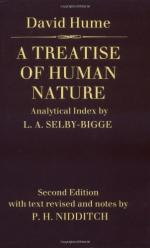II. The second objection is derived from the necessity there would be of penetration, if extension consisted of mathematical points. A simple and indivisible atom, that touches another, must necessarily penetrate it; for it is impossible it can touch it by its external parts, from the very supposition of its perfect simplicity, which excludes all parts. It must therefore touch it intimately, and in its whole essence, SECUNDUM Se, Tota, et TOTALITER; which is the very definition of penetration. But penetration is impossible: Mathematical points are of consequence equally impossible.
I answer this objection by substituting a juster idea of penetration. Suppose two bodies containing no void within their circumference, to approach each other, and to unite in such a manner that the body, which results from their union, is no more extended than either of them; it is this we must mean when we talk of penetration. But it is evident this penetration is nothing but the annihilation of one of these bodies, and the preservation of the other, without our being able to distinguish particularly which is preserved and which annihilated. Before the approach we have the idea of two bodies. After it we have the idea only of one. It is impossible for the mind to preserve any notion of difference betwixt two bodies of the same nature existing in the same place at the same time.
Taking then penetration in this sense, for the annihilation of one body upon its approach to another, I ask any one, if he sees a necessity, that a coloured or tangible point should be annihilated upon the approach of another coloured or tangible point? On the contrary, does he not evidently perceive, that from the union of these points there results an object, which is compounded and divisible, and may be distinguished into two parts, of which each preserves its existence distinct and separate, notwithstanding its contiguity to the other? Let him aid his fancy by conceiving these points to be of different colours, the better to prevent their coalition and confusion. A blue and a red point may surely lie contiguous without any penetration or annihilation. For if they cannot, what possibly can become of them? Whether shall the red or the blue be annihilated? Or if these colours unite into one, what new colour will they produce by their union?
What chiefly gives rise to these objections, and at the same time renders it so difficult to give a satisfactory answer to them, is the natural infirmity and unsteadiness both of our imagination and senses, when employed on such minute objects. Put a spot of ink upon paper, and retire to such a distance, that the spot becomes altogether invisible; you will find, that upon your return and nearer approach the spot first becomes visible by short intervals; and afterwards becomes always visible; and afterwards acquires only a new force in its colouring without augmenting its bulk; and afterwards, when it has encreased to such a degree as to be really extended, it is still difficult for the imagination to break it into its component parts, because of the uneasiness it finds in the conception of such a minute object as a single point. This infirmity affects most of our reasonings on the present subject, and makes it almost impossible to answer in an intelligible manner, and in proper expressions, many questions which may arise concerning it.




